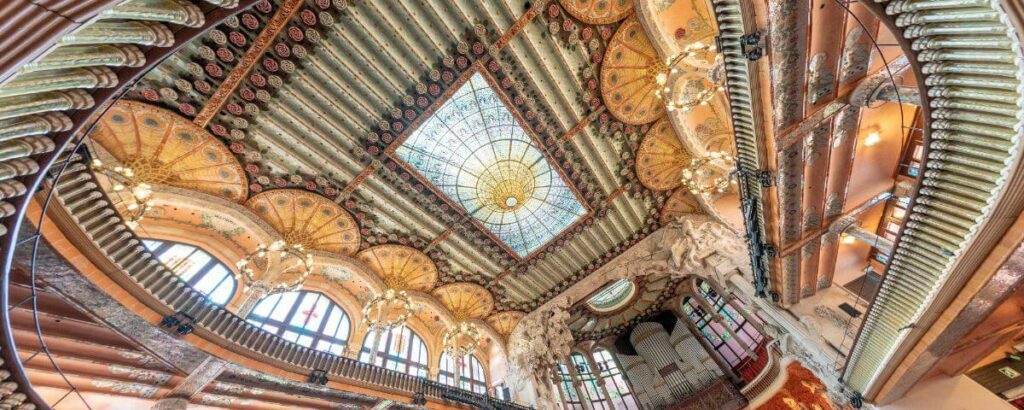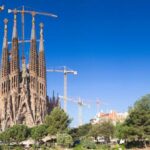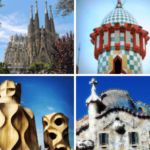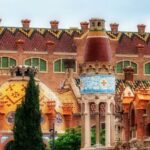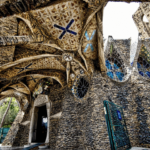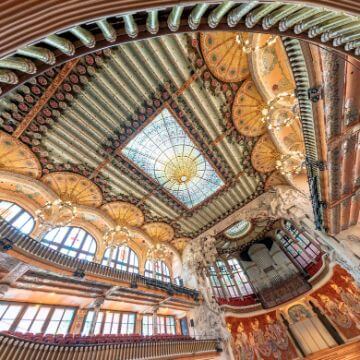
Is Palau de la Música Catalana worth a visit?
ALL ABOUT THE PALACE OF CATALAN MUSIC
The most beautiful modernist concert hall in Barcelona is not by Antoni Gaudí, but by his teacher and leader of Modernism, Lluis Domenech i Montaner, who directed the construction works between 1905-1908. The building was designed to be the headquarters of the Orfeo Catala, a society created to promote music in the Catalan world, specially through choirs. Their focus wouldn’t be just the preferences of the cultural elites, but also the Catalonia traditions and the working classes, who through those choirs had access to more educated music styles.
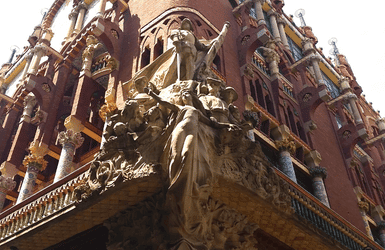
Domenech i Montaner envisioned a building that would be an antem to Music, profusely decorated with sculptures related to local and international musicians, people singing, muses playing instruments... The treatment of light to enhance the inside of the concert hall, and the solutions to perfect its acustic conditions included innovative techniques and materials for the time. The demolition of the church next door in the 1980's made possible and additional entrance of light (already planed by Montaner, who was thinking ahead) and the construction of a modern wing containing additional service areas, a restaurant and a second smaller concert hall.
What you'll see during your palau de la musica visit
1
The façade of the Catalan Music Palace
The best point to observe the façade of the Barcelona Palau de la Musica is from the corner with Amadeo Vives street. There raises a large sculpture representing the “popular catalan song”, where several characters representing the Catalan society sing along, surrounding a young girl that symbolizes “The Song”, and topped by Saint George – patron saint of Catalonia. You can recognize a group of farmers and a group of fishermen, as well as mothers and their children of different social levels. A farmer holds an arm of The Song, meaning that the singing belongs to the people of Catalonia. The fishermen are the ones that help Catalan music travel around the world on their ships. Mothers transmit the traditional songs to the younger generations.
From the corner you also get a nice view of the balcony on the second floor, with its famous columns decorated with flower mosaics. You’ll also see sculpted portraits of famous composers: Bach Beethoven, Palestrina and Wagner. On the street level you can still see the (now closed) little windows of the original ticket offices, decorated also with colorful mosaics.
2
The foyer of the Palau de la Musica
3
Sala Lluís Millet and balcony of the columns
Lluís Millet was the founder of the Orfeo Catala and a promoter of the construction of the Palau de la Musica Catalana in Barcelona. This room of very high ceilings is decorated with modernist paintings and leads to a balcony overlooking the street from the main façade. The iconic balcony features 14 columns completely covered in colorful mosaic tiles. Each column is different and is dedicated to a different type of flower.
4
The concert hall of the Palau de la Musica Catalana
The main concert hall of the Palau de la Música is a marvel for the senses. Starting from the fascinating stage, surrounded by delicate figures of the muses of music playing instruments and framed by powerful sculptures inspired in Wagner’s Valkyries, and continuing with the mesmerizing 3D skylight over the theater stalls, representing a sun surrounded by women singing. Everything there speaks beauty: the chandeliers, the beams decorated with roses, the columns opening like peacock feathers…
There’s two more concert halls in El Palau de la Musica: the Rehearsal room, located right underneath the stage of the main hall, and often used for also for small concerts and conferences, and the Petit Palau, a modern auditorium perfect for camera music and located in the new wing of the building.
Palau de la Música tour types
6
Group guided tours
For years, this was the only option to visit Palau de la Musica Catalana outside of attending a concert or other event. You’ll join a group of other visitors, an a professional licensed tour guide will show you around the building. The visit takes 50 minutes to 1 hour, and it is available in English, Spanish, French, Italian and Catalan. In some occasions the groups are even allowed to access the stage or hear the organ play.
It is always a good idea to book your tour in advance, because the tickets tend to sell out, plus there’s often lines at the ticket offices.
7
Self-guided tour
Audioguide tours have been available in the Palau de la Musica Catalana since the pandemic, but for sanitary reasons you are required to bring your own headphones. The visit covers the same spots visited in the guided tours, except for the possibility of getting on the stage. Besides the languages mentioned for the group guided tours, the audioguides are also available in Korean.
This option is great for people who don’t feel comfortable in group settings, or aren’t particularly punctual. But beware, in order to control the building capacity, even audioguide tours are timed, but you’ll have a 30 minute slot to arrive. Booking online is a smart way to avoid any lines at the box office.
8
Are there private tours in the Barcelona Palau de la Musica?
While the administration of Palau de la Música does not allow people visiting with their own tour guides (and that applies to large groups as well as individuals with their own private guide), it is possible to arrange a private tour by contacting them directly. But the cost of such services isn’t displayed on their website… you know what that means.
Concerts at the Palau de la Música Catalana
9
Flamenco and Spanish Guitar concerts
Your time in Barcelona is short and you have to be selective on where to go for actual “sightseeing”. You have Palau de la Musica Catalana in your must-see list, probably as well as attending a flamenco show, since you are in Spain. Am I right? A smart solution to kill two birds with one stone is to attend a flamenco show or a guitar concert in the Palace of Catalan Music! You’ll get to do both in one evening!
10
Other music styles
The original philosophy of the founders of the Palau, approaching music to the people, continues to be alive. Palau de la Musica Catalana isn’t a concert hall for the elites: it’s for everyone. Their program is busy with events pretty much every day: classical music, jazz, flamenco, pop, rock, choirs… Everything is welcome, as long as it’s quality music. So if no flamenco or Spanish guitar show is available during your stay, do check their program to see what else is on: you might be surprised! (and you’ll see many more Barcelona locals attending, too).
Additional tips to visit the Palau
11
Location and how to get there
Telephone: +34 295 72 00 and +34 93 855 57 31
Website: https://palaumusica.cat/ Subway: Urquinaona (L1 and L4). The next closest station is Catalunya (L1 and L3, as well as FGC and Rodalies trains
Hop-on Hop-off bus stop: Plaça de Catalunya (blue and red routes). Get your hop-on hop-off bus tickets here.
12
Opening hours
VISITS:
The opening hours depend mostly on the concerts for that day, as they might have to adjust the visit hours to the time needed to prepare each event. In any case, the ticket offices are open 8.30AM to 3.30PM. The earliest tour is 9AM.
CONCERTS:
Most concerts start sometime between 7PM and 9PM, although it’s not unusual to see some starting as early as 5 or 6PM. Family concerts usually take place in the mornings or around noon in the Petit Palau hall.
FOYER CAFE:
Open everyday from 9AM until midnight.
13
Eating near the Barcelona Music Palace
Having dinner is always a concern when you are attending a concert: you need something that is close enough. The most convenient option to consider is the bar of the Foyer, the Cafe Palau. They serve a dozen different tapas, a short menu of surprisingly affordable prices considering the location, and Mon-Fri they also serve a lunch special for a set price. That’s additional to the bakeries, snacks, coffe and beverages served all day.
And did you know Palau de la Musica has a second restaurant? Pizzicato (formerly Mirador del Palau) is an oyster Bar specializing in seafood, smoked fish, tartares and some meats, and has also some vegan options. Perfect for a fancy-not-too-fancy meal pre or after concert.
And here are some more alternatives:
- Tapas from Spain: Casa Alfonso, Casa Lolea, El Bitxo, Tosca Palau
- Meat: Asador de Aranda
- Catalan: La Cuina de Laietana
- Italian: Cucine Mandarosso, Luigi
- Vegetarian: Flax & Kale Passage
- Fast Food: You’ll find plenty of chains on Urquinaona Street and Ronda de Sant Pere.
Are you going to visit the Palace of Music (Barcelona, Spain)?
Marta
RESEARCHING FOR A TRIP IS TIME-CONSUMING…
Need more inspiration?
Our 100% FREE Barcelona Collection will give you everything you need to organize the trip of your lifetime to Barcelona.
BEST INSIDER TIPS FROM THE PROS!

Last update on 2024-04-23 / Affiliate links / Images from Amazon Product Advertising API

